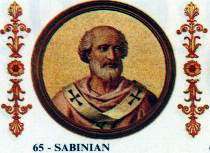Pope Sabinian
| Pope Sabinian | |
|---|---|
 | |
| Papacy began | 13 September 604 |
| Papacy ended | 22 February 606 |
| Predecessor | Gregory I |
| Successor | Boniface III |
| Personal details | |
| Birth name | Sabinian |
| Born | Blera, Eastern Roman Empire |
| Died |
22 February 606 (aged 76) Rome, Eastern Roman Empire |
| Previous post | Cardinal-Deacon of the Holy Roman Church (15 October 590 - 13 September 604) |
Pope Sabinian (Latin: Sabinianus, d. 22 February 606) was Pope from 13 September 604 to his death in 606, during the Byzantine (Eastern Roman) domination of the Papacy; he was the fourth former apocrisiarius to Constantinople to be elected pope.
Biography
Sabinian was born at Blera (Bieda) near Viterbo. He had been sent by Pope Gregory I as Apostolic nuncio, to Constantinople, but he apparently was not entirely satisfactory in that office. He returned to Rome in 597.[1] He was probably consecrated pope on 13 September 604.
The erudite Italian Augustinian Onofrio Panvinio (1529–1568), in his Epitome pontificum Romanorum (Venice, 1557), attributes to him the introduction of the custom of ringing bells at the canonical hours and the celebration of the Eucharist.[2] The first attribution of this was in Guillaume Durand's thirteenth-century Rationale Divinorum Officiorum.[1]
During his reign, Sabinian was seen as a counterfoil to his predecessor Pope Gregory I. He incurred unpopularity by his unseasonable economies,[2] although the Liber Pontificalis states that he distributed grain during a famine at Rome under his pontificate. Whereas Gregory distributed grain to the Roman populace as invasion loomed, when the danger had passed Sabinian sold it to them. Because he was unable or unwilling to allow the people to have the corn for little or nothing, there grew up in later times a number of idle legends in which his predecessor was represented punishing him for avarice. Sabinian died 22 February 606. His funeral procession through the city had to change course to avoid hostile Romans.[3]
The Liber Pontificalis praises him for "filling the church with clergy," in contrast to Gregory, who tended to fill ecclesiastical positions with monks rather than the diocesan clergy.[1]
See also
Notes
- 1 2 3

- 1 2

- ↑ "The 65th Pope", Spirituality.org, Diocese of Bridgeport
References
- Duffy, Eamon. Saints and Sinners: A History of the Popes, Yale University Press, 2001, p. 72–73. ISBN 0-300-09165-6
- Ekonomou, Andrew J. 2007. Byzantine Rome and the Greek Popes: Eastern influences on Rome and the papacy from Gregory the Great to Zacharias, A.D. 590–752. Lexington Books.
- Maxwell-Stuart, P. G. Chronicle of the Popes: The Reign-by-Reign Record of the Papacy from St. Peter to the Present, Thames & Hudson, 2002, p. 54. ISBN 0-500-01798-0.
External links
| Wikimedia Commons has media related to Sabinianus. |
| Catholic Church titles | ||
|---|---|---|
| Preceded by Gregory I |
Pope 604–606 |
Succeeded by Boniface III |

